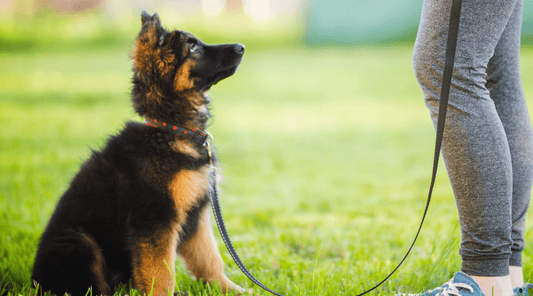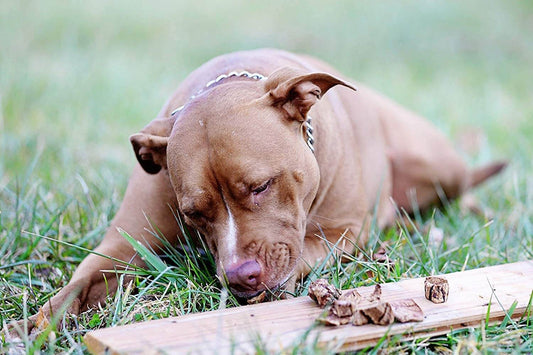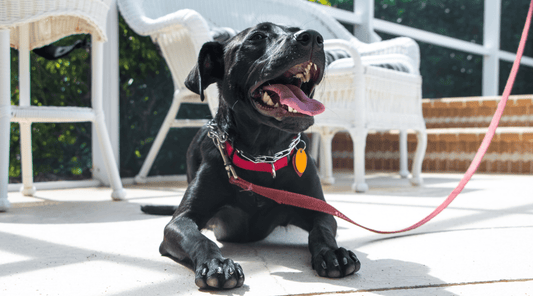
Dog Teeth Cleaning: Why I Don't Brush Their Teeth
Dawn Miller Mar 26, 20255 Minute ReadHave you ever settled into relaxation mode after a long day when suddenly, your favorite pup in the whole world jumps up beside you and...
The smell? Unforgettable. Unforgivable.
A mix of old socks, fish, and something vaguely rotten. I love my dogs, but I do not love their bad breath attacks. And I know it's not their fault.
But this happens a lot less in our home since I taught my dogs how to brush their teeth. That's right. I didn't brush my grown kid's teeth once they reached a certain age. And I'll admit. I'm not that into dog teeth cleaning.
Here's what I do instead.
Why Dog Teeth Cleaning is So Important
Now, I don't want to give the wrong impression. I think learning how to clean your dog's teeth at home is critical. Dog dental health = overall health.
85% of dogs over age three have some level of dental disease. That's a young dog in my book.
Tartar and plaque buildup leads to painful infections that make eating difficult, not to mention the knock-your-socks-off bad breath that comes with dog tooth decay.
Untreated dental problems can cause kidney, liver, and heart issues. Current evidence suggests that bacteria may travel through the bloodstream to other parts of the body after gaining access through bleeding gums.
Then there's the relationship you have with your dog. Pups like to lick faces and cuddle. It's not fair to them if I have to push them away because I can't take the heat—of nasty dog breath.
And here's the really sad part: dogs don’t show pain the way we do. They might keep eating even with sore, infected gums—until it’s really bad.
Of course, vet cleanings are important. But I think my dentist would have a problem if I showed up after not brushing my teeth for six months.
Regular dog teeth cleaning at home means less pain, fewer vet bills, and a healthier, happier pup.
It's important to clean your dog's teeth; no two ways about it. So, even though I pamper my K9s in every other way, why don't I brush my dogs' teeth?
I'll tell you. But first.
Dog Tooth Decay: The Warning Signs
If your dog’s breath smells like something died, it might not just be their diet—it could be early tooth decay.
Signs your dog’s teeth need attention include:
- Bad breath (beyond normal “dog breath”). Healthy dog breath doesn't have a strong odor. If anything, it kind of smells like kibble or your dog themselves.
- Yellow or brown tartar buildup along the gumline.
- Red, swollen, or bleeding gums.
- Difficulty chewing or favoring one side of the mouth.
- Excessive drooling or pawing at the mouth.
- Squishy mouth noises
Notice any of these? It’s time for a dental check-up and some serious at-home cleaning.
How to Clean Dog’s Teeth at Home
You have options for dog teeth cleaning at home. Here's what many will recommend. And I'm all about providing you with all the information you need to decide for your dogs.
1. Brushing with Dog-Safe Toothpaste
Yep, just like humans, dogs benefit from regular brushing.
If you go this route, use dog-friendly toothpaste (never human toothpaste—it often contains xylitol, which causes an unsafe drop in blood sugar and possibly coma, even in healthy dogs).
Try a dog toothbrush or a fingerbrush. Don't use a human one. I'll admit that finger toothbrushes for dogs are second best to getting your dog to brush their own teeth. They give you the most control and cause the least discomfort.
Start slow—let them lick the toothpaste first to get used to it. It's best to start socializing them to mouth touching as puppies.
2. Feed a Diet That Supports Oral Health
What your dog eats matters. The other day, I was on Quora, and someone asked why people in the Middle Ages didn't have worse teeth since they didn't brush.
As the answerer explained, a lot of it comes down to diet. Adding sugar to food is a relatively new invention. And guess what? We're doing it to dog food, too! Many dog treats contain sugar, artificial flavors and texturizers. These aren't good for dogs' teeth or health.
I choose single-ingredient dog treats like grass-fed beef marrow bones and lung bites. There's nothing but the real beef flavor here.
Dog treats can also be the source of nutrients that support oral health like:
- Collagen for healthy teeth and gums
- Omega 3 healthy fats for lower inflammation
- Omega 6 for balanced immune systems
- Calcium, zinc, and phosphorous for strong teeth
- And the list goes on.
My dogs also get this canine nutrition through dog treats and dog bones.
3. Use Water Additives
These are like mouthwash, but they are okay to swallow. If your dog won’t let you near its mouth, try water additives or dental sprays.
- These help kill bacteria and freshen breath.
- They reduce plaque buildup over time, but not as much as getting your dog to brush its own teeth.
- They’re easy—just add to your dog’s water bowl!
4. Teach Your Dog to Brush Their Teeth
My dogs' ancestral wolves must clean and protect their teeth. If they don't, they can't hunt or eat, and that's a death sentence in the wild. So, dogs have developed a natural instinct to clean their teeth. They do it by chewing on things: running shoes, door frames, table legs, and your children's toys.
We usually call this "destructive chewing". But this is just a dog trying to brush their teeth.
If we understand this instinct, we can give this dog a natural toothbrush instead.
Natural toothbrushes have hard ridges that act like bristles, helping your dog scrape away plaque and tartar as they chew.
The best dental dog chews are single ingredient (no added sugar) and enhance nutrition. So they can improve breath and oral health from multiple angles. Most dog treats can't do this.
The Best Dental Chews for Dogs
Trachea Chews
I like to start with beef trachea chews. This is just a roasted cow's windpipe. And nothing else.
It's mostly cartilage, which is collagen, with many other essential vitamins and minerals dogs need. And just check out those teeth-cleaning ridges. There is nothing artificial here.
That's why I call these "natural toothbrushes".
Marrow Bones
Dogs love dog bones. These bones feed their chewing instincts for keeping teeth clean. And this isn't just speculation. A Rutgers study found that just 12 weeks of regular dog bone sessions reduced harmful bacteria in the mouth by 60-80%. That bacteria no longer had somewhere to hide.
Bone marrow is also very nutritious, with collagen, calcium, phosphorus, B vitamins, and healthy fats. Just make sure you choose grass-fed beef bones.
Grass-fed cattle have 2.5X the anti-inflammatory omega 3 versus conventionally-fed cows.
K9 Connoisseur’s all-natural marrow bones are:
- Single-ingredient
- Sourced from USA-born and raised grass-fed cattle
- Long-lasting (unlike processed chews that break and dissolve before they get to work). One bone can last for many chewing sessions.
- Can stop destructive chewing
- Keep breath smelling fresh
- Available in several sizes so your dog can safely enjoy a dog bone
Want a well-trained dog with great dental health?
Join our 7-Day Dog Training Challenge to learn positive reinforcement techniques—and get tips on using healthy treats to reward good behavior.
Available On:


Disclosure: This article may contain affiliate links, which means we may earn a small commission if you make a purchase through these links—at no extra cost to you. We only recommend products we trust and believe will benefit you and your K9.



